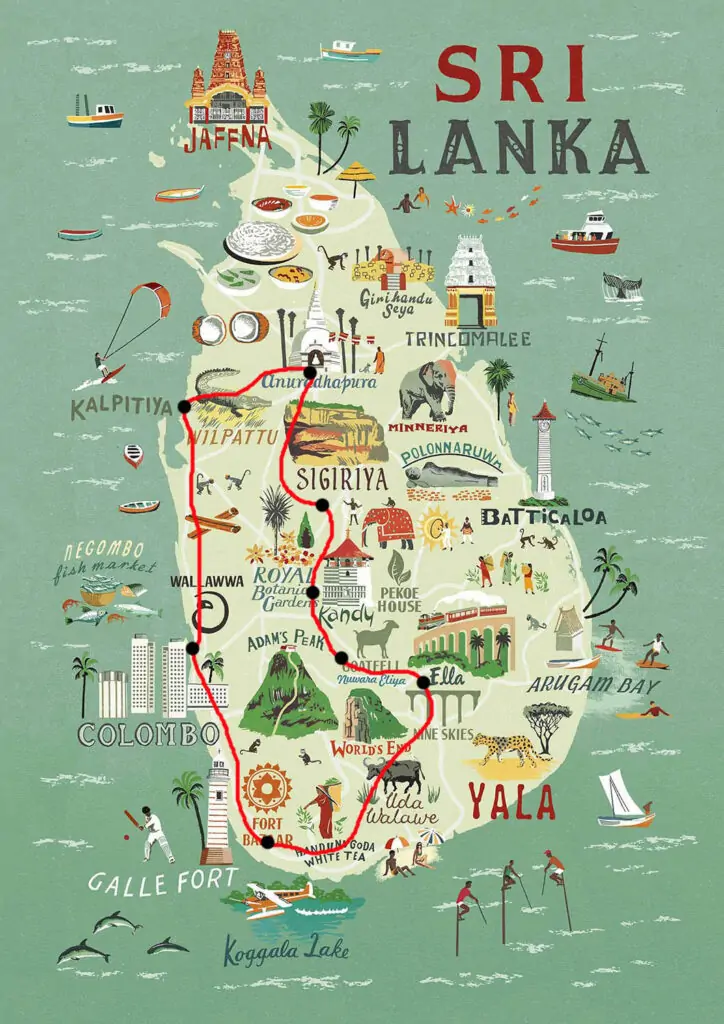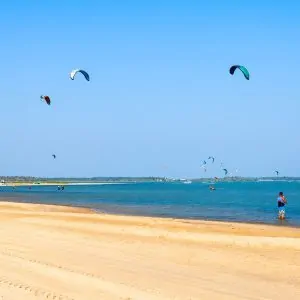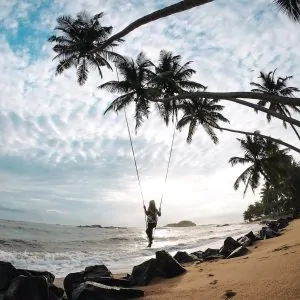Menu
Airport to Kalpitiya – Leisure at Kalpitiya Beach , Explore kalpitiya.
Kalpitiya to Anuradhapura – Wilpattu National Park , Explore Anuradhapura
Anuradhapura to Dambulla – Ritigala Monastery Complex , Sigiriya Rock fortress.
Dambulla to Kandy – Dambulla Cave Temple , Nalanda gedige , Kandy Temple, Explore Knuckles Mountain Ramge.
Kandy to Nuwara Eliya -Gem Museum And Experiencing Gem Cutting , Ramboda Water Fall , Lesiure in Nuwara Eliya , Visiting Tea Factory , Lover’s Leap Water fall , Hakgala Botanical Garden
Nuwara Eliya to Ella – Nine Arch Bridge , Little Adam’s Peak , Ella Rock , Cookery Lessons.
Ella to Galle- Ravana Water Fall , Buduruwagala Temple , Galle Dutch Fortress.
Galle to Airport – Turtle Hatchery , Ambalangoda Mask Museum.


Kalpitiya, located on the northwest coast of Sri Lanka, is a rising star among tourist destinations in the country. This little town, consisting of 14 islands, boasts stunning natural beauty, diverse wildlife, and a laid-back atmosphere, making it ideal for travelers seeking an off-the-beaten-path adventure.
Escape the hustle and bustle of busy tourist destinations and immerse yourself in the laid-back charm of Kalpitiya. The local fishing community adds to the town’s authentic character, and the uncrowded beaches offer a peaceful haven for relaxation.
Here’s what makes Kalpitiya a captivating tourist attraction. Kite surfing ,Lagoon Kayaking , dolphin and whale watching tour , diving and snorkeling experiences , historic Dutch Fort and Wilpattu Safari park.
Watersports Paradise- Kalpitiya is renowned as Sri Lanka’s premier destination for kitesurfing, thanks to its shallow lagoon with consistent winds and flat waters.
Marine Life Encounters- The seas around Kalpitiya teem with marine life, making it a haven for nature lovers. Embark on an unforgettable dolphin and whale watching tour, where you might encounter playful spinner dolphins, majestic blue whales, or even the acrobatic humpback whales.
Underwater Adventures: Explore the vibrant coral reefs and diverse marine life beneath the waves. Kalpitiya offers world-class diving and snorkeling experiences, especially around the Bar Reef, Sri Lanka’s largest. Witness a kaleidoscope of colorful fish, fascinating coral formations, and even occasional sightings of gentle giants like manta rays and reef sharks.

The biggest and oldest park in Sri Lanka. located in the nation’s north. The word “Willus” refers to lakes. There are more lakes in the park than these. There are a lot of leopards in the world. It is renowned for having an enormous variety of birds and reptiles. The first Sri Lankan king, King Wijaya, is said to have landed his army at Kudiramalii point, which is located inside the park. With us, you might take part in an exciting safari.
Visit Anuradhapura, Sri Lanka’s first capital and a UNESCO World Heritage Site. Anuradhapura was formerly a prosperous monastic city that produced a remarkable civilization and distinctive culture. This vanished metropolis was found in the 19th century by British explorers. See a number of historically and archaeologically significant locations in Anuradhapura, including the Sacred Bo-Tree (Sri Maha Bodhi), the right branch of the secret Bodhi tree, which is where Buddha attained enlightenment, and Ruwanweliseya, one of the world’s oldest known historical trees, which was constructed by King Dutugemunu. You’ll be astounded to experience royalty and spirituality combined on this historical voyage.

The Ritigala Monastery Complex is an ancient Buddhist monastery located in Sri Lanka, situated about 43 kilometers away from the ancient city of Anuradhapura. The ruins and rock inscriptions found at the complex date back to the 1st century BCE. Believed to have been established during the reign of King Devanampiyatissa (307-267 BC). Abandoned following invasions in the 10th and 11th centuries and Rediscovered by the British in the 19th century.
The Ritigala Monastery Complex is a fascinating place to visit for anyone interested in Sri Lankan history, Buddhism, or archaeology. It’s also a popular spot for hiking and nature enthusiasts, offering stunning views from the mountaintop.
Unforgettable architecture, steeped in history and culture. Built over a thousand years ago by a king hiding from the reckoning of his patricide, Sigiriya (or the “Lion’s Rock”) is a historical site that was once both an ancient castle and impenetrable fortress, with symmetrical water gardens.
Your trek up the rock will take you past timeworn paintings of the king’s concubines, and past a gateway guarded by the remains of a giant lion statue that gave the rock its name. You’ll have to climb up around 1,200 steps to reach the top. Sigiriya is one of Sri Lanka’s most iconic attractions, and is definitely not to be missed.

King Walagamba constructed the Dambulla Rock Temple in the first century B.C. The largest and best preserved cave temple complex, spanning an area of approximately 2,100 m², is the main draw of Dambulla. A UENESCO World Heritage Site is Dambulla. Aside from the 153 Buddha statues dotted around the five caverns and the remarkably maintained paintings, there is nothing quite like the breathtaking vista of the boundless plains and reservoirs
Nalanda Gedige is a stone remains of an 8th-10th century Hindu Dravidian style temple and Sri Lanka’s center point. While built in the Dravidian style, Nalanda Gedige displays both Hindu and Buddhist elements. This unique fusion is evident in the mandapam (hall) and ambulatory path, typical of Hindu temples, yet it lacks Hindu deities and features Tantric Buddhist carvings similar to those found in Khajuraho, India.
Its original location was considered the geographical center of Sri Lanka, adding to its historical and cultural importance. Explore the ruins of the temple, marvel at the intricate carvings, and immerse yourself in the unique blend of Hindu and Buddhist influences.
The Kandy Dalada Maligawa, also known as the Temple of the Sacred Tooth Relic, is a renowned Buddhist temple in Kandy, Sri Lanka. It houses a relic believed to be a tooth of Lord Buddha. The temple is an important pilgrimage site and a UNESCO World Heritage site, known for its cultural and religious significance.

The Knuckles Range, also known as the Dumbara Mountain Range, is situated near Kandy in Sri Lanka’s Northern Central Highlands. One of Sri Lanka’s most charming natural landmarks is the Knuckles Range. The Knuckles Mountain Range, spanning 18512 hectares, is a trekker’s dream come true with its varied landscape of meadows, craggy mountain peaks scattered with streams and tumbling waterfalls. The Knuckles Mountain Range is a World Heritage Conservation Area with fascinating trekking opportunities. It is still mostly unspoiled and has remarkable natural beauty and wildlife.

Visiting a gem museum and experiencing a gem cutting demonstration are both fantastic ways to delve into the fascinating world of Sri Lankan gems. Sri Lanka, also known as the “Island of Gems”, boasts a long and rich history in the gem trade. Gems like sapphires, rubies, and moonstones have been mined and exported from the island for centuries, and the country is still a major source of these precious stones today.
During a gem cutting demonstration, you’ll see how rough gemstones are transformed into the sparkling beauties we see in jewelry stores. Most gem museums in Sri Lanka showcase a wide variety of rough and cut gemstones, from the common to the incredibly rare. Museums have interactive displays where you can learn more about gems and even try your hand at identifying them.
The Ramboda Ella waterfall is a beautiful sight, and it’s definitely worth to visit.
The waterfall is actually a series of three falls, with the tallest one being 109 meters high. The middle fall is the most popular swimming spot, and the lower fall is the easiest to get to.
The Ramboda Falls Hotel is right next to the lower fall, and the Blue Field Tea Factory is a short drive away.
for the second fall, need to do little hike. The Ramboda Falls Hotel is right next to the lower fall, and the Blue Field Tea Factory is a short drive away.
Nuwara Eliya, also known as the “City of Lights” or “Little England,” is a charming hill station in Sri Lanka known for its cool climate, stunning scenery, and colonial-era architecture. It’s a popular destination for leisure activities, offering a variety of experiences to suit different interests.
Take a stroll through the picturesque Victoria Park, the largest park in Nuwara Eliya. Enjoy the vibrant flower displays, boat on the lake, or simply relax on the green lawns.
Walk around or Take a boat ride on Gregory Lake a man-made lake surrounded by rolling hills and lush greenery. Visit the nearby Galway Forest Reserve for nature walks and birdwatching. Browse the shops and stalls in Nuwara Eliya town for souvenirs, local crafts, and fresh produce.
Visiting a tea factory in Sri Lanka is a must-do for any tea lover or anyone who wants to experience the country’s rich history and culture. Sri Lanka is the world’s fourth-largest tea producer, and its lush hill country is home to some of the most beautiful tea plantations in the world.
No matter which tea factory you choose to visit, you’re sure to have a memorable experience. Here are a few things you can expect to see and do on a typical tea factory tour: Watch the leaves being withered, rolled, fermented, and dried. / Learn about the different grades of tea. / Enjoy a tasting of different Ceylon teas
Lover’s Leap Waterfall is a beautiful waterfall located near Nuwara Eliya, Sri Lanka. It is a popular tourist destination, known for its scenic beauty and tragic legend. The waterfall is about 30 meters high and cascades over a rocky cliff into a pool below.
Despite the legend, Lover’s Leap Waterfall is a beautiful place to visit. The hike to the waterfall is relatively easy and takes about 30 minutes. Once you reach the top, you can enjoy stunning views of the surrounding countryside. There is also a small pool at the base of the waterfall where you can go swimming (be cautious and follow safety guidelines)
Hakgala Botanical Garden is the second largest botanical garden in Sri Lanka, boasting a rich and diverse collection of plant life. Established in 1861, the garden is situated at an elevation of 5,400 feet above sea level, offering a cool and refreshing escape from the tropical heat.
It was originally established for the cultivation of cinchona, a medicinal plant used to treat malaria. Some of the highlights of the garden include the Rose Garden, the Japanese Garden, and the Fern Glade. The garden is home to over 10,000 plant species, including both native and introduced varieties.
The Seetha Amman Kovil in Nuwara Eliya, Sri Lanka, is a sacred Hindu temple nestled amidst lush greenery. It is dedicated to Goddess Seetha, a central character in the Indian epic, Ramayana. Pilgrims visit to pay their respects and immerse themselves in the temple’s serene and spiritual atmosphere.

The Nine Arch Bridge in Ella, located in Sri Lanka’s Uva Province, is a stunning architectural marvel nestled amidst lush green hills. This iconic bridge, built during the British colonial era, features nine picturesque stone arches that span a picturesque valley, creating a popular attraction for tourists seeking breathtaking views and historical charm.
Before you go check on the train schedule and start the trekking 30 minutes earlier. However, be sure to carry your trusty cam with you so that you might capture every moment that unravels before you.
Little Adam’s Peak is a picturesque hill located in Ella, Sri Lanka. Standing at 1,141 meters above sea level, it offers breathtaking panoramic views of lush green tea plantations, dramatic landscapes, and the iconic Ella Rock. A popular hiking destination, it’s a relatively easy trek, making it perfect for nature lovers and photographers seeking stunning vistas.
It is not a challenging hike and it`s quite short, but gives you a good impression of the landscape around Ella and the view is fantastic! So absolutely worth the climb! If you don`t have that much time in Ella, we highly recommend taking the hike up to Little Adam`s Peak.
Ella Rock, located in the charming town of Ella in Sri Lanka, is a prominent rock formation offering breathtaking panoramic views. A popular hiking destination, it rewards trekkers with lush green landscapes, tea plantations, and a stunning vista from its summit, making it a must-visit for nature enthusiasts and adventurers.
The round trip to Ella’s rock will take approximately 4 hours, depending on how quick you walk and how much time you spend at the top. Make sure that you pack plenty of water and snacks, a hat and suncream and you’ll need mosquito spray!
Sri Lanka has a long history of culinary culture. It is influenced by Indian, Indonesian, Portuguese, and Dutch cuisines. However, rice, spices, and coconut milk predominate in the majority of the regional cuisine. You will learn firsthand how numerous meals are made, what ingredients are needed, and how to control temperature with burners made locally. Acquire the unique spices and relish preparing your own meal. Although you won’t become a chef overnight, you will be knowledgeable about Sri Lankan culinary customs.

Ravana Falls, located near Ella in Sri Lanka, is a magnificent waterfall cascading from a rocky cliff. Standing at 82 feet (25 meters) tall, it is surrounded by lush greenery and is a popular tourist attraction. According to local folklore, Ravana Falls is associated with the epic tale of the Ramayana, making it a culturally significant site.
In Sri Lanka’s Uva Province, there is a well-known archeological site called Buduruwagala. It is well-known for its enormous rock carvings, which are up to 51 feet tall and feature three standing Buddhas. These exquisitely carved statues, which are said to have originated in the ninth or tenth century, are a draw for tourists looking for insights into the local Buddhist culture
Since the 14th century, Galle has been Sri Lanka’s principal port. The Portuguese constructed Galle’s first fort. Enjoy the breathtaking view of the ocean as you stroll along the fort’s walls, and don’t forget to watch the sun set for an even more breathtaking vista from the Galle walls.
Galle Fort is the most beautiful coastal town in Sri Lanka. Here, h a unique fusion of European and Asian influences, as seen in the whitewashed Dutch-style buildings that line the cobbled streets. Head to the most southwestern corner of the country and enjoy all the beautiful things to do in Galle Fort, Sri Lanka.
The story of the Galle Dutch Fort; a UNESCO World Heritage Site reverberates through every traveller’s photos and captions. Initially built by the Portuguese in the 16th century during their conquests, the fort was later fortified and conquered by the Dutch in the 17th century, until it later fell to the might of the British. The old town of Galle was once used as a trading port for spices and other goods for over 200 years. However, today, the fort has been transformed into a place of history, romance and beauty where travellers are warmly welcomed to dive head first into the exotic stories and be a part of this heritage site

Hawksbill, Olive Ridley, Loggerhead, Green, and Turtle are the five species of sea turtles that can be found in Sri Lanka. The Galle District contains all of the important nesting areas. You’re going to a hatchery, where the locals gather eggs to hatch and feed the young turtles.
Here you will find lots of information about Sri Lanka’s pioneering sea turtle conservation project – why Sri Lanka is a prime turtle nesting site, why the conservation project is needed and how the project is operated by local people with the help of international volunteers.
The production of masks is a long-standing enterprise that dates back to the reign of the Kings. Masks are handmade and painted by hand using very light trees. Ambalangoda is the well-known location for masks, and there is a factory and a museum there. You are free to choose the greatest piece if you would like to own one that will protect you from bad luck.
WhatsApp us